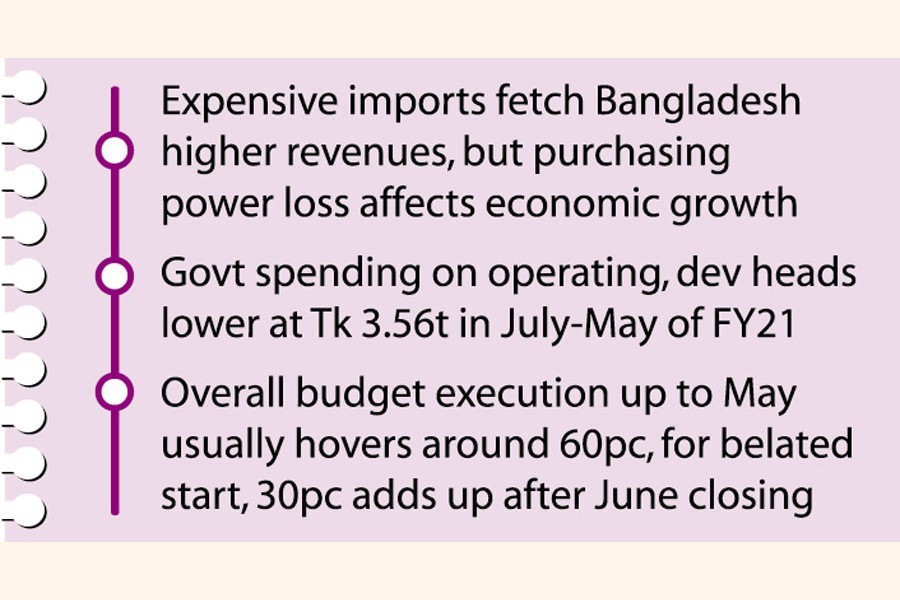Financial stocktaking of crunch-time past fiscal
Import cuts, demand squeeze contain fiscal deficit

Published :
Updated :

Belt-tightening to weather a global crunch yields contrasting outcomes for Bangladesh as it enjoys lower fiscal deficit for demand shrinkage and higher taxes from expensive imports while economic growth falters.
High-rated inflation driven particularly by global and local price rises erodes people's purchasing power that dampens demand and finally affects economic activity, economists say about the financial situation the country passed through in the past fiscal.
The country's fiscal deficit for the eleven months to May of the fiscal year 2021-22 was much lower than expected, at Tk 165.39 billion or 0.41 per cent of the GDP, helped by lower spending on development projects and higher tax collection, government data show.
Such low deficit in state expenditure for 11-month period happened after many years.
The deficit or a shortfall in government income compared to its spending was 1.34 per cent of the GDP or gross domestic products in the fiscal year 2020-21 for the July-May period, in 2019-20 2.32 per cent, in 2018-19 it was 1.99 per cent and in 2017-18 [July-May] 1.03 per cent.
The tax collection grew to over 83 per cent of the annual target, partly due to higher import duty and value-added tax.
Import duty, having around 10-percent share in total revenues, registered 122-percent growth or Tk 461.7 billion during the period-mainly being pushed by high prices of imported goods.
The value-added tax or VAT collection was nearly 99 per cent of the target during the period under review.
Although the total tax mobilisation grew to Tk 3.395 trillion, the tax-GDP ratio still remained a poor 7.7 per cent, down by 1.0 percentage points from the annual target.
On the expenditure side, government spending on both operating and development heads was much lower than the expectations during the period. Total expenditure was Tk 3.56 trillion during July-May period of the past fiscal year (FY2021-22).
Major operating expenditures were pay and perks for government servants accounting for over 81 per cent of the total allocation of Tk 697.46 billion for the whole fiscal year.
Interest payments grew to 92 per cent of the total allocation of Tk 685.89 billion. Subsidy payments expanded to 73.3 per cent of Tk 344.99 billion. And pension and gratuity-related expenditure stood at 68 per cent of the total resources meant to meet the liabilities of Tk 282.09 billion.
The overall development expenditure was nearly 40 per cent of the targeted Tk 2.37 trillion-leaving, as usual, the lion's share to be splurged in the last month of a fiscal.
People in the finance division said the development spending would increase significantly after the June accounts were taken into account. Historically Bangladesh's overall budget-execution rate up to May remains around 60 per cent, evidently for a belated start of budget execution.
After June closing, around 30 per cent of spending usually adds up to the total expenditure as the government starts to release all pending bills.
However, this is a clear indication that the targeted fiscal deficit of 5.4 per cent of GDP for the past fiscal year would remain under control despite headwinds on the economic front, especially for the war in Ukraine since February.
The deficit was 4.49 per cent of the GDP in full 12 months from July to June in FY2021. It was just 1.34 per cent in an 11-month period in the same fiscal year.
The budget-execution rate was 80 per cent of the original budget for the 12 months in FY 2021. And the revenue target achieved nearly 87 per cent in the entire FY. Surprisingly in FY 2022, in 11 months [July-May] the revenue achieved 83 per cent.
Dr Masrur Reaz, chairman at Policy Exchange of Bangladesh, a private think- tank, feels the fiscal deficit for FY 2022 will be much lower than the target as there were no tax-duty cuts or additional spending announced for June last.
"The deficit will remain much lower than estimation," he says, posing the question: "Can we raise the spending at least 12 times higher in one month [June 2022]?"
He thinks the government spending was lower for two reasons: there were two months-July and August--of the last fiscal year when there was Covid-related slow economic activity and it again surfaced in January due to the spread of the omicron variant of the coronavirus.
Dr Reaz notes that the middle-income-bracket people have lost purchasing power due to higher inflation since December last. "There was lower consumption on the economy since December last." Poor consumption means the aggregate demand for goods and services falls and consequently the GDP-growth rate falls.
jasimharoon@yahoo.com


 For all latest news, follow The Financial Express Google News channel.
For all latest news, follow The Financial Express Google News channel.